#native news
Text
THE ICWA HAS BEEN UPHELD 7-2
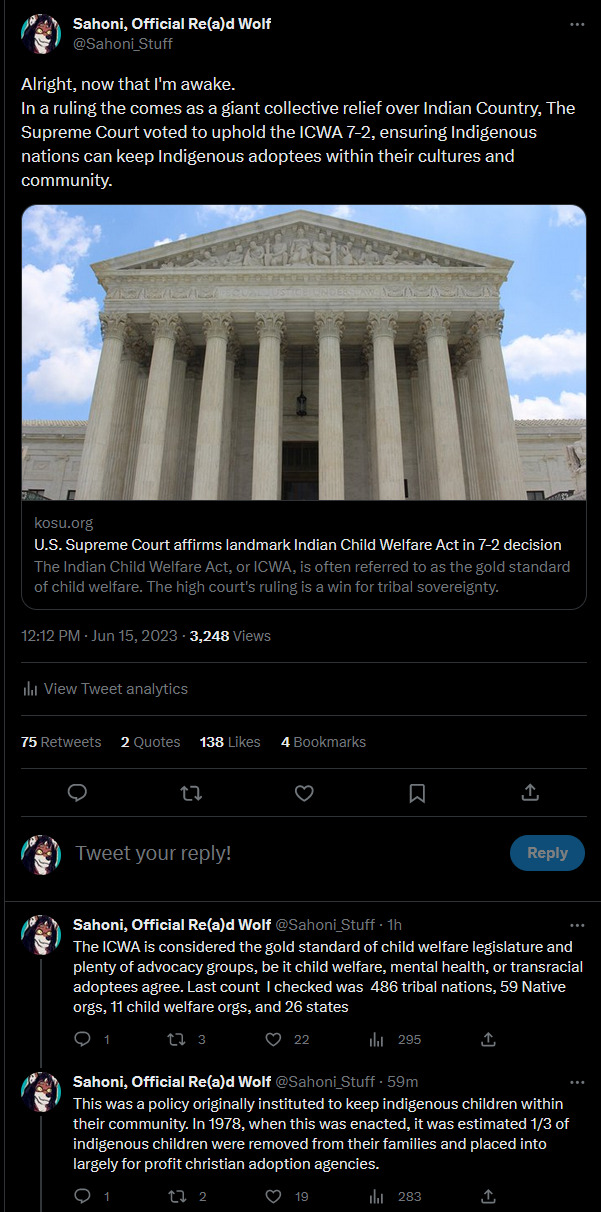
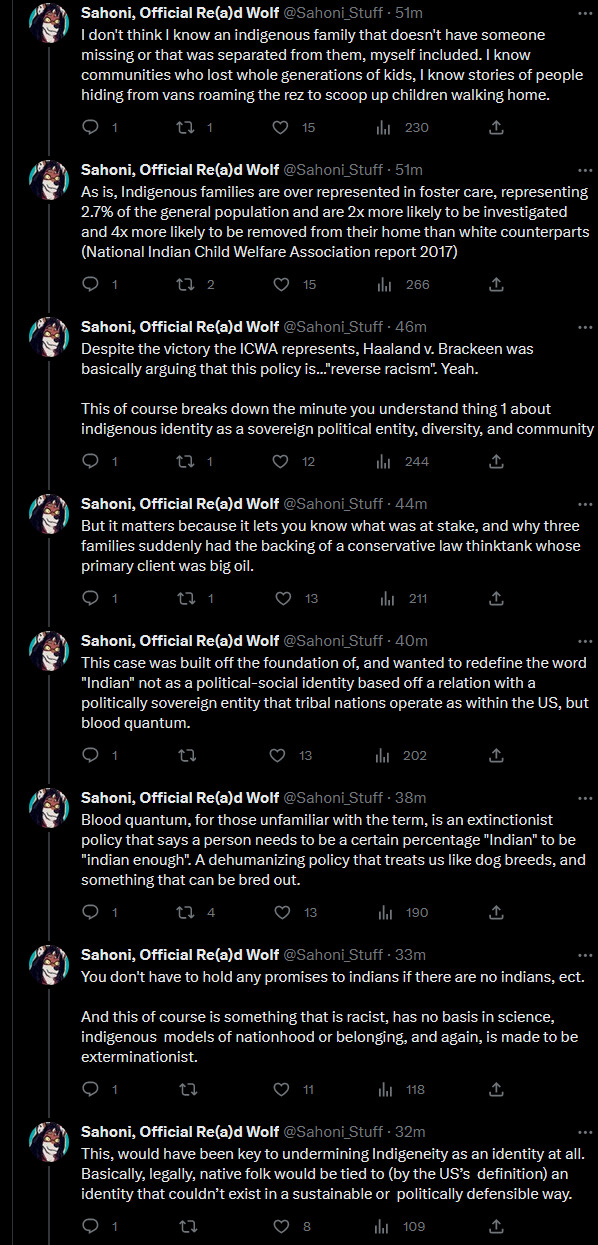
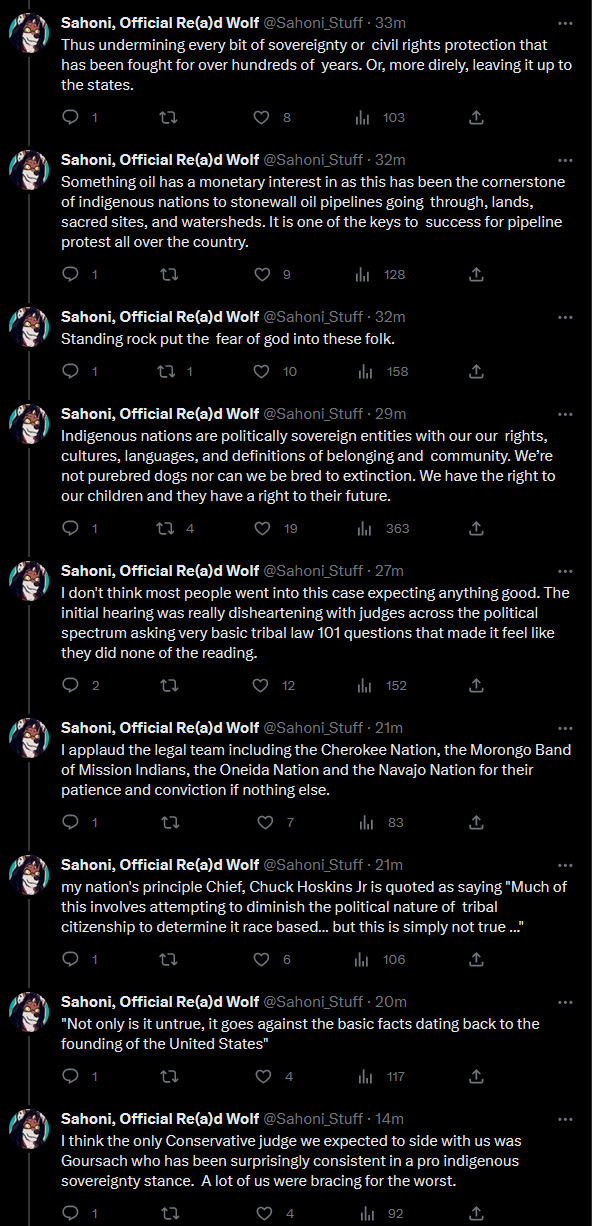
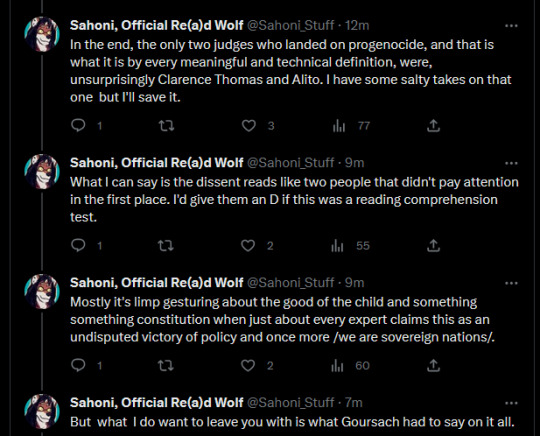
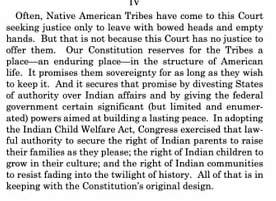
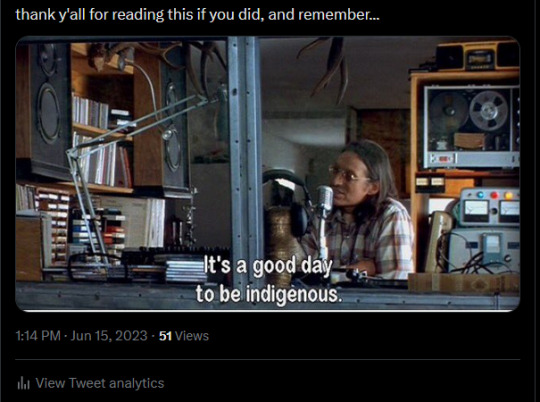
872 notes
·
View notes
Text
Tribes welcome return of ancestral lands
Tuesday, February 14, 2023
By Kevin Abourezk, Indianz.Com
Kimberly Morales Johnson can’t help but imagine the land that today is Los Angeles as her ancestors would have seen it centuries ago. The Tongva people used the canyons of the San Gabriel Mountains as trading routes with the indigenous people of the Mojave desert. Last year, the Tongva reclaimed land in Los Angeles for the first time in almost 200 years after being forced to give up their lands and having their federal status terminated by President Dwight D. Eisenhower in 1950.
Sharon Alexander, a non-Native woman, donated a one-acre property in Altadena, California, to the Tongva after learning about the #LandBack movement during the 2016 Democratic National Convention and discovering that the Tongva were the original inhabitants of Los Angeles.
Johnson, vice president of the Tongva Taraxat Paxaavxa Conservancy, a nonprofit set up by the community to receive the land, said the tribe has big plans for the property. “It needs a lot of work, but we’re all dedicated to it,” she said.
In 2022, thousands of acres of private and public land in America were returned to the care of Native peoples. Many of these lands were returned to their original inhabitants, including the one-acre property in Los Angeles.
A website called the Decolonial Atlas created a “Land Back” map charting the locations of land returns that occurred last year. Other land returns that occurred last year include 40 acres around the Wounded Knee National Historic Landmark, the site of the 1890 Wounded Knee Massacre. The Oglala Sioux Tribe and the Cheyenne River Sioux Tribe bought the land for $500,000.
“It’s a small step towards healing and really making sure that we as a tribe are protecting our critical areas and assets,” Oglala Sioux Tribe President Kevin Killer told The Associated Press.
Although not a land return, the Biden administration last year signed an agreement giving five tribes – the Hopi, Navajo, Ute Mountain Ute, Ute Indian Tribe of the Uintah and Ouray Reservation, and Pueblo of Zuni – greater oversight of the 1.3-million acre Bears Ears National Monument in Utah.
Last year, the Rappahannock Tribe celebrated the return of more than 400 acres along the Rappahannock River that is home to a historic tribal village named Pissacoack and a four-mile stretch of white-colored cliffs.
“Your ancestors cherished these lands for many generations and despite centuries of land disputes and shifting policies, your connections to these cliffs and to this river remain unbroken,” Secretary of the Interior Deb Haaland said at an event celebrating the land return. One of the largest land returns last year involved the purchase of more than 28,000 acres by the Bois Forte Band of Chippewa Tribe in Minnesota.
The Conservation Fund, an environmental nonprofit, sold the land to the tribe after purchasing the land from a lumber manufacturer in 2020. Emilee Nelson, Minnesota associate state director of The Conservation Fund, said her organization bought the land from the PotlatchDeltic Corporation after the company decided to divest of much of its Minnesota land holdings. The Conservation Fund bought 72,000 acres from the company, including 28,000 acres that were within the Bois Forte Reservation. The Boise Fort Band lost the land following passage of the Dawes Act of 1887, which led to the allotment of the land to private landowners. “Where this land was located made a lot of sense for the tribe to own it,” Nelson said.
However, he said, tribes don’t always want to purchase land or even accept a land donation, especially if they don’t think they’ll be able to put it into federal trust status. He offered advice to those considering donating their land to a tribe. “If you want to make a donation, sell the land and make a donation,” he said.
As for the one-acre land donation to the Tongva, Kimberly Morales Johnson said the tribe plans to use the land to create a community center where it will be able to host cultural workshops and where Tongva people will be able to gather plants sacred to their people, including the acorns from the oak trees on the property.
“This is about self-determination and sovereignty,” she said. The tribe is also allowing a tribal artist to live on the land and take care of it, she said. The Tongva have also begun working to return Native plants to the property and remove invasive species.
“This whole LandBack movement is rooted in healing, and instead of looking at land as a commodity, we’re looking at it as a way to have a relationship with the land and with each other and bringing back our traditions, our language, our food, our culture,” she said.
200 notes
·
View notes
Note
Longtime follower, first time interacting:
No question, just wanted to share some good news out of a local community. I'm a school teacher in northern california in a region with a lot of Natives and also a region where a lot of white people have a generally...well, it doesn't compare to the depth of trauma Native people have but there are deep scars here from CAMP and the number of families torn apart and family farms torched by the DEA.
So no one here loves the government.
But when a lot of the local tribes got turned down for language funding by the Fed, it actually wound up making the county officials interested in fundraising education programs at the local schools to help native kids learn their ancestral tongues.
Well, them, and settler kids who were either invited, just wanted to learn, had indigenous ancestry but not tribal culture (lot of intermarriage up here).
The motive was partially spite for the federal government, but it seems to have had good effects - there's enough second-language speakers that at least Yurok and Wiyot are starting to turn around their fights for language preservation.
Thought in the midst of all the tragedy and national failure you could do with some positive news from a local theater.
HOPE
😭😭😭😭
51 notes
·
View notes
Text

I have no words.
1 note
·
View note
Text
"With “green corridors” that mimic the natural forest, the Colombian city is driving down temperatures — and could become five degrees cooler over the next few decades.
In the face of a rapidly heating planet, the City of Eternal Spring — nicknamed so thanks to its year-round temperate climate — has found a way to keep its cool.
Previously, Medellín had undergone years of rapid urban expansion, which led to a severe urban heat island effect — raising temperatures in the city to significantly higher than in the surrounding suburban and rural areas. Roads and other concrete infrastructure absorb and maintain the sun’s heat for much longer than green infrastructure.
“Medellín grew at the expense of green spaces and vegetation,” says Pilar Vargas, a forest engineer working for City Hall. “We built and built and built. There wasn’t a lot of thought about the impact on the climate. It became obvious that had to change.”
Efforts began in 2016 under Medellín’s then mayor, Federico Gutiérrez (who, after completing one term in 2019, was re-elected at the end of 2023). The city launched a new approach to its urban development — one that focused on people and plants.
The $16.3 million initiative led to the creation of 30 Green Corridors along the city’s roads and waterways, improving or producing more than 70 hectares of green space, which includes 20 kilometers of shaded routes with cycle lanes and pedestrian paths.
These plant and tree-filled spaces — which connect all sorts of green areas such as the curb strips, squares, parks, vertical gardens, sidewalks, and even some of the seven hills that surround the city — produce fresh, cooling air in the face of urban heat. The corridors are also designed to mimic a natural forest with levels of low, medium and high plants, including native and tropical plants, bamboo grasses and palm trees.
Heat-trapping infrastructure like metro stations and bridges has also been greened as part of the project and government buildings have been adorned with green roofs and vertical gardens to beat the heat. The first of those was installed at Medellín’s City Hall, where nearly 100,000 plants and 12 species span the 1,810 square meter surface.
“It’s like urban acupuncture,” says Paula Zapata, advisor for Medellín at C40 Cities, a global network of about 100 of the world’s leading mayors. “The city is making these small interventions that together act to make a big impact.”
At the launch of the project, 120,000 individual plants and 12,500 trees were added to roads and parks across the city. By 2021, the figure had reached 2.5 million plants and 880,000 trees. Each has been carefully chosen to maximize their impact.
“The technical team thought a lot about the species used. They selected endemic ones that have a functional use,” explains Zapata.
The 72 species of plants and trees selected provide food for wildlife, help biodiversity to spread and fight air pollution. A study, for example, identified Mangifera indica as the best among six plant species found in Medellín at absorbing PM2.5 pollution — particulate matter that can cause asthma, bronchitis and heart disease — and surviving in polluted areas due to its “biochemical and biological mechanisms.”
And the urban planting continues to this day.
The groundwork is carried out by 150 citizen-gardeners like Pineda, who come from disadvantaged and minority backgrounds, with the support of 15 specialized forest engineers. Pineda is now the leader of a team of seven other gardeners who attend to corridors all across the city, shifting depending on the current priorities...
“I’m completely in favor of the corridors,” says [Victoria Perez, another citizen-gardener], who grew up in a poor suburb in the city of 2.5 million people. “It really improves the quality of life here.”
Wilmar Jesus, a 48-year-old Afro-Colombian farmer on his first day of the job, is pleased about the project’s possibilities for his own future. “I want to learn more and become better,” he says. “This gives me the opportunity to advance myself.”
The project’s wider impacts are like a breath of fresh air. Medellín’s temperatures fell by 2°C in the first three years of the program, and officials expect a further decrease of 4 to 5C over the next few decades, even taking into account climate change. In turn, City Hall says this will minimize the need for energy-intensive air conditioning...
In addition, the project has had a significant impact on air pollution. Between 2016 and 2019, the level of PM2.5 fell significantly, and in turn the city’s morbidity rate from acute respiratory infections decreased from 159.8 to 95.3 per 1,000 people [Note: That means the city's rate of people getting sick with lung/throat/respiratory infections.]
There’s also been a 34.6 percent rise in cycling in the city, likely due to the new bike paths built for the project, and biodiversity studies show that wildlife is coming back — one sample of five Green Corridors identified 30 different species of butterfly.
Other cities are already taking note. Bogotá and Barranquilla have adopted similar plans, among other Colombian cities, and last year São Paulo, Brazil, the largest city in South America, began expanding its corridors after launching them in 2022.
“For sure, Green Corridors could work in many other places,” says Zapata."
-via Reasons to Be Cheerful, March 4, 2024
#colombia#brazil#urban#urban landscape#urban planning#cities#civil engineering#green architecture#green spaces#urban heat#urban heat island effect#weather#meteorology#global warming#climate change#climate hope#climate optimism#climate emergency#climate action#environment#environmental news#city architecture#bicycling#native plants#biodiversity#good news#hope#solarpunk#ecopunk#hopepunk
13K notes
·
View notes
Text
genuinely it will never stop baffling me how people will wear twilight shirts and talk about team Edward vs team Jacob and then the same people will be like "I'm not basing my personality off of a piece of media (harry potter) made by a transphobe 😌" like good that's great! so you can excuse racism but you draw the line at transphobia? good to know
#remember when twilight came out and there were news articles about the quileute tribe and also if you read the books with your eyes#you know that theyre extremely like INSANELY racist#i remember reading them at age 10 and thinking 'wow this author hates women and native americans'#and i was right bc later i found out shes mormon 😐#begging you all to take racism and especially pretty extreme racism against natives seriously lmfao
21K notes
·
View notes
Text
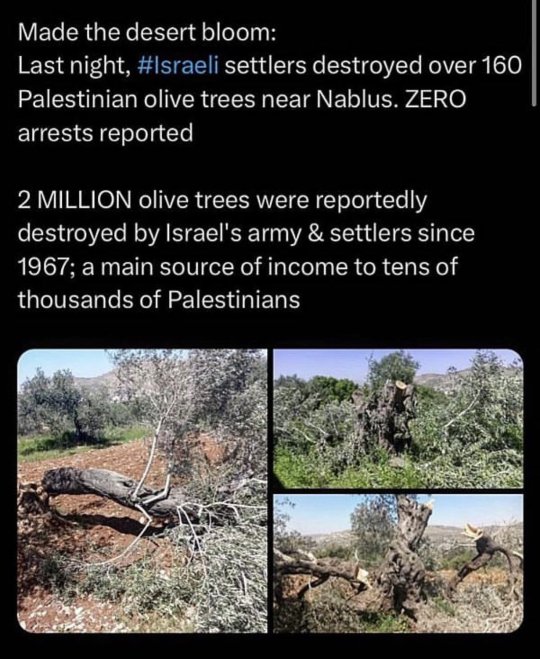

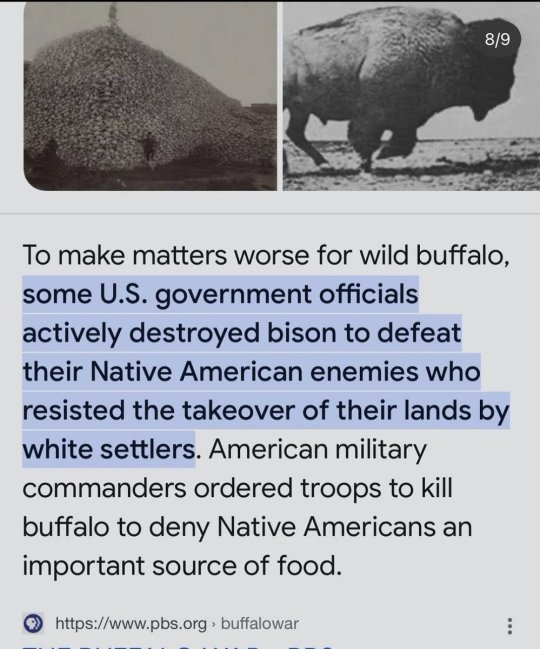
US literally is a teaching guide for war crimes.
#free palestine#politics#news#palestine#west bank#democrats#republicans#trees#botany#nature#native americans#military#woc#poc#women of color#colonialism#colonization#usa
8K notes
·
View notes
Text
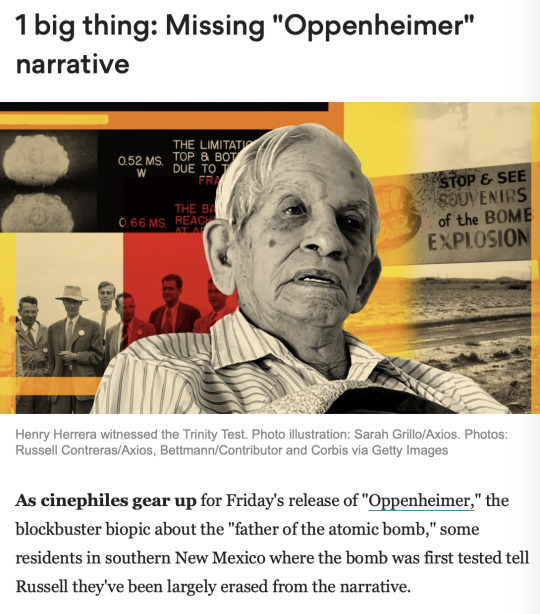




Full story here
21K notes
·
View notes
Text


The forest king and the postwoman
#artists on tumblr#art#illustration#character design#oc#digital art#SORRY for reposting but I wasn't satisfied with the sketches so I'm making a new post without it#postwoman#the postwoman#adalore#king of the forest#original#original character#Ill draw more of him because I love him#also he is beautiful to any human but for all natives of the world the postwoman lives in he is UGLY AF
11K notes
·
View notes
Text

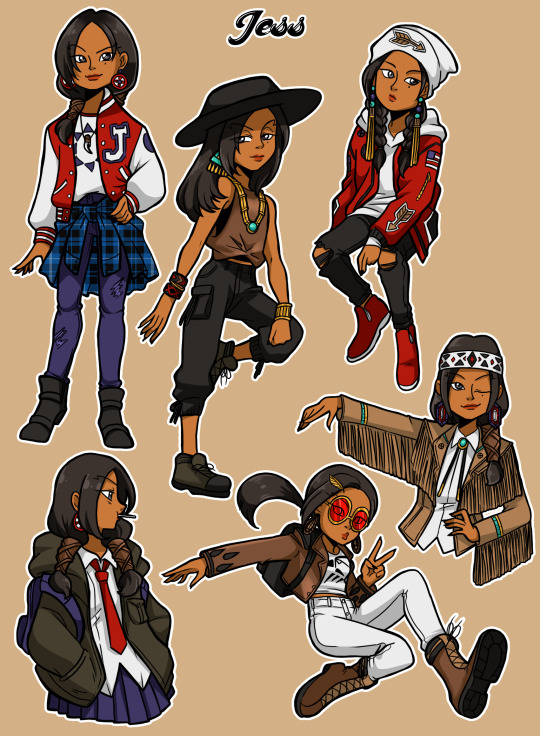




Some "Special" Girls! And the late girls.
Ko-fi | Patreon
#you don't even know how long I've held onto the Zoe one I made her with the quickness#I still haven't seen the Shanghai or New York Special I went in mostly blind on their looks#all the 'Specials' girls did get a redesign from me so the version where their mimicking their render pose is the redesign#though I kept Jess's hair wraps even though I don't love them#I know Native American people DO wrap their hair sometimes but I think it was to cop-out of animating her braids#my art#fashion#ml paris special#emonette#jess#aeon#new york special#fei#shanghai special#socqueline#zoe#socqueline wang#zoe lee#marinette#marinette dupain-cheng#ml art#miraculous ladybug
5K notes
·
View notes
Text
Fake Indian art still a major problem despite federal responsibilities
Criminal pleas surface amid vague ‘Indigenous’ claims
Tuesday, March 14, 2023
By Acee Agoyo, Indianz.Com
Efforts to strengthen the Indian Arts and Crafts Act are gaining new steam as government authorities try to enforce a law aimed at addressing fraud and exploitation of Native cultures and ways of life. On Monday, the Democratic chairman of the Senate Committee on Indian Affairs unveiled a discussion draft bill called the Amendments to Respect Traditional Indigenous Skill and Talent Act of 2023. Also known as the ARTIST Act [PDF], the proposed legislation seeks to protect the arts, crafts, goods and other creative works that American Indian, Alaska Native and Native Hawaiian people have produced since time immemorial.
“The ARTIST Act would update the Indian Arts and Crafts Act to support creative economies and strengthen enforcement of current law and protections against counterfeit competition for Native artists and their works,” the committee said in a news release on behalf of Sen. Brian Schatz (D-Hawaii), the chair of the legislative panel. “This discussion draft reflects direct stakeholder input as well as years of committee oversight and broad commitment to the protection of Native cultural patrimony and revitalization of Indigenous languages,” the release continued.
As enacted in 1990, the Indian Arts and Crafts Act makes it a crime to market, sell or promote an item as “Indian” unless it was created by a citizen of a state or federally recognized tribe or by an artisan certified by a tribe. The law was written to prevent the historical and ongoing misrepresentation of Native arts by non-Native entities. Yet Native artists and their advocates have long complained about the lack of enforcement as fakes and frauds have continued to flood the market and undermine an important source of income in Native communities across the United States.
It’s an issue that Secretary Deb Haaland, who is the first Native person to lead the Department of the Interior, has recognized as a major problem. “Native art is a critical part in telling the story of this country and can only be told by Native artists,” Haaland said in a video message after making history as the first Native person in a presidential cabinet. “Buying authentic pottery, jewelry, mixed-media creations, paintings and other art from Native American artists helps support tribal economies.” “Unfortunately forgery and copies hinder the positive economic opportunities available to Native artists and their families,” said Haaland, who is a citizen of the Pueblo of Laguna.
youtube
The law was updated in 2000 and in 2010 to strengthen enforcement. But as fraudulent works continue to be sold in some of the largest art markets in the U.S., the ARTIST Act builds on prior efforts by broadly expanding the ways in which federal officers can investigate suspected violations. Federal officers, for instance, would be authorized to make arrests, engage in searches and even conduct seizures for suspected violations of the Indian Arts and Crafts Act.
They would also be able to inspect shipments coming into the U.S. to ensure compliance with the law, according to provisions of the draft. And for the first time, Native Hawaiians would gain protections for their creative works. The ARTIST Act modifies existing definitions in federal law to ensure that the original inhabitants of Hawaii aren’t left out of enforcement efforts that are available to American Indian and Alaska Native artisans.
To help pay for these enforcement measures, the ARTIST Act authorizes ways in which people suspected of violating the law can have their property forfeited and be required to shoulder the costs of investigations through fines and penalties. A new Indian Arts and Crafts Forfeiture Fund would be established to assist the work of the Department of the Interior.
The draft discussion bill also requires visible and permanent labeling of items that come into the U.S. from Canada or Mexico. Anything that could “possibly be mistaken for, arts and crafts made by Native Americans” must be “indelibly marked with the country of origin,” according to provisions of the the ARTIST Act.
Finally, the ARTIST Act would require trainings of federal law enforcement officers, not only on the Indian Arts and Crafts Act but on the recently-enacted Safeguard Tribal Objects of Patrimony Act, also known as the STOP Act. The latter law makes it a crime to export tribal cultural property, another issue that has threatened Native cultures and ways of life. “For too long, the export and sale of sacred and culturally significant items from Native peoples in Hawaiʻi, Alaska, and across Indian Country has deprived these communities of their own history and heritage,” Schatz said after the measure was passed and signed into law during the prior session of Congress. “Our bill will help stop the black market trafficking of these items and bring them home.”
Just this month alone, federal authorities announced the resolution of three cases in which the Indian Arts and Crafts Act was violated. In all three instances, non-Natives created and sold fraudulent art by misrepresenting, falsifying and lying about their non-existent tribal backgrounds. In Washington, 52-year-old Lewis Anthony Rath and 67-year-old Jerry Chris Van Dyke, also known as Jerry Witten, pleaded guilty on March 1 to breaking the law.
Both men admitted that they sold fake “Indian” goods in the historic Pike Place Market in Seattle, one of the most heavily trafficked tourist areas in the city. “When non-Native artists falsely claim Indian heritage, they can take sales away from true Indian artists working to support themselves with skills and techniques handed down for generations,” Nick Brown, the U.S. Attorney for the Western District of Washington, said in a news release. “Stores and galleries need to partner with artists to ensure those artisans and craftsmen advertised as Indian Artists truly have tribal status,” Brown added, offering advice to businesses to ensure they comply with the law.
Rath falsely claimed to belong to the San Carlos Apache Tribe — while producing items that mimicked the Pacific Northwest tribal cultures that are hundreds of miles from his supposed Native homeland in Arizona. According to federal authorities, the goods were sold at the Raven’s Nest Treasure and the Ye Olde Curiosity Shop, both of which represented to customers that Rath was Native. And when agents from the U.S. Fish and Wildlife Service, which is part of the Department of the Interior, searched Rath’s home and studio, they found feathers from protected birds — including ones from golden eagles. He pleaded guilty to unlawful possession of these items in addition to violating the Indian Arts and Crafts Act.
Meanwhile, Van Dyke falsely claimed to be from the Nez Perce Tribe and was selling goods that he claimed were of Alaska Native origin — again far away from his supposed tribal background in Idaho. According to federal authorities, he produced the items using materials that were supplied to him by the non-Native owner of a gallery in Pike Place.
“Van Dyke had worked with the gallery for more than ten years, with the gallery owner providing him with woolly mammoth ivory, antlers, animal bones and fossilized walrus ivory to make the pendants that it sold,” the U.S. Attorney’s Office for the Western District of Washington said in the March 1 news release. A day later in Texas, the U.S. Attorney for the Western District announced the sentencing of Kevin Charles Kowalis, 60, for violating the law. According to federal authorities, he falsely marketed and sold jewelry online that he claimed were of “Zuni” and “Navajo” origin even though he does not belong to either tribal nation.
“Fraud can come in many forms but always carries the intent to deceive a victim,” U.S. Attorney Jaime Esparza of the Western District of Texas said in a news release. “Offenders like this defendant victimize both our cherished Native American community and consumers who believe they’re collecting authentic pieces of Native American culture. We will not stand idle while someone takes advantage of our citizens and our federal resources.” Kowalis will serve five years probation for his crime and was ordered to forfeit his inventory, pay a special assessment and pay restitution to a victimized artist from the Pueblo of Zuni.
The total amount appears to be relatively low — less than $1,500, according to court records. No fines were ordered due to his “inability to pay,” the criminal judgment reads. “This sentencing is important in the fight to end this type of fraud,” said Assistant Director Edward J. Grace of the U.S Fish and Wildlife Service’s Office of Law Enforcement. “Our dedicated team of special agents works on behalf of the Department of the Interior and the Indian Arts and Crafts Board to protect American Indian and Alaska Native artists and the consumers who purchase authentic Native American art and craftwork.”
Over in Washington, Rath and Van Dyke are due to be sentenced on May 17. As part of a plea agreement, federal prosecutors said they won’t seek prison time for Van Dyke. Rath did not obtain any promises regarding sentencing in his plea agreement. A federal judge, though, will make the final determination on punishments for both individuals.
“The Indian Arts and Crafts Board (IACB) is very pleased that Jerry Chris Van Dyke and Anthony Rath have been brought to justice for their roles in selling fake Indian artwork in violation of the Indian Arts and Crafts Act,” said Director Meridith Stanton, the leader of the IACB, which is part of the Department of the Interior. “Cases like these are critical to preserving the integrity and viability of authentic Native American art and craftwork in general, as well as preserving the rich cultural heritage of the Nez Perce Tribe and the San Carlos Apache Tribe and the economic livelihoods of their artists and craftspeople,” said Stanton.
The IACB helps look into potential violations of the Indian Arts and Crafts Act, offering examples of possible wrongdoing. But the board’s website notes that items that are marketed or portrayed as “Native American style” or “Native American inspired” can be sold without violating the law — so long as there is “qualified labeling” available to the consumer.
The draft discussion of the ARTIST Act maintains the legality of these categories of “Native American-style jewelry” and “Native American-style arts and crafts” but requires that such items be “indelibly marked” or labeled in a “permanent” fashion, to ensure the consumer is aware that they are not produced by an American Indian, Alaska Native or Native Hawaiian artist.
And while the title of the ARTIST Act contains the word “Indigenous,” the proposed bill does not contain any definitions of a term that has become increasingly used by people who are creating, marketing and selling art that they claim is Native in origin.
An example just emerged in New York, where a self-described activist opened an exhibit in February that appropriates numerous elements of Native culture even after admitting to Indianz.Com that they do not belong to any tribal community. The exhibition, located at a small gallery in the Upper East Side of New York City, notably incorporates the red imagery that Native women developed and brought to prominence to raise awareness to their missing and murdered sisters and relatives. It also includes a visual representation of a Native quilted blanket — albeit with the word “PRETENDIAN” stitched into it.
The Soul of Nations Foundation has prominently marketed the installation as “Indigenous” in origin, a designation that has prompted some Native people to consider reporting it to the Indian Arts and Crafts Board for possible violations of the Indian Artist and Crafts Act. In fact, the non-profit’s executive director and founding member, Ernest Hill, contacted Indianz.Com numerous times in advance of the opening on February 24, soliciting news coverage for an individual who removed all references to their supposed tribal affiliation over a year ago.
Yet Hill, whose parents served as religious missionaries to the Navajo Nation and to other reservations, has since refused to answer questions about the exhibition — including inquiries about the artist’s supposed tribal background.
Materials that Soul of Nations produced for the installation claim it is directed to “Indian Country” but the organization has repeatedly refused to respond to inquiries about the use of the designation in connection with someone who admitted they lack ties to any tribal community. Hill and Soul of Nations also have refused to clarify the source of funding for the project.
In press materials, they proudly assert that the installation has received “support” from the Department of State. On social media, Hill and Soul of Nations gave a different story. In response to a prominent Native environmental leader who has repeatedly attempted to hold the self-described activist accountable for the false claims of tribal belonging, they claimed that “no outside funding was provided for this exhibition.”
When asked to explain the discrepancy between the press materials and the social media post regarding their claim of receiving federal support, Hill and the Soul of Nations refused to respond. The organization started blocking Native users on social media and began restricting interactions on one of its accounts after questions were raised about the installation. The Soul of Nations website, incidentally, includes a prominent reference to the “Senate Committee on Indian Affairs” on a page that has been used to solicit monetary donations. The Department of State is also listed in the same section of the site.
Since the opening of the installation last month, the self-described “Indigenous” individual has posted on social media about being on “Day 371” of a “cancel” and a ‘call out” that has purportedly kept them “jobless.” The number of days is counted from the February 25, 2022, story on Indianz.Com that reported on their their non-existent tribal affiliations. The next post on the private account was about the installation, which opened to the public a year following publication of the story. The user has since deleted hundreds of posts about their supposed tribal background from the account, whose name is a variation of an anti-LGBTQ slur.
The Senate Committee on Indian Affairs is accepting comments about the Amendments to Respect Traditional Indigenous Skill and Talent (ARTIST) Act of 2023 until April 14. Comments can be sent to [email protected].
#art#native american#indigenous#indigenous artists#native news#scams#frauds#us politics#us government#indian law#native art#indigenous art#native artists#current events#Youtube
69 notes
·
View notes
Text
When indigenous and formally colonized people from ALL OVER THE GLOBE are showing solidarity with Palestine, ask yourself why you chose to stand with the occupation
5K notes
·
View notes
Text

#usa#america#australia#australian#slavery#chattel slavery#us government#us govt#made in usa#usa news#united states#unitedstateofamerica#native american#amerikkka#amerika#wage slavery#ausgov#politas#auspol#tasgov#taspol#fuck neoliberals#neoliberal capitalism#anthony albanese#albanese government#land of the free#contradiction#contradictory#false statements#fraud
3K notes
·
View notes
Text



Source
#politics#us politics#government#the left#native rights#indigenous#news#current events#progressive#activism
3K notes
·
View notes
Text
"The Yurok will be the first Tribal nation to co-manage land with the National Park Service under a historic memorandum of understanding signed on Tuesday [March 19, 2024] by the tribe, Redwood national and state parks, and the non-profit Save the Redwoods League, according to news reports.
The Yurok tribe has seen a wave of successes in recent years, successfully campaigning for the removal of a series of dams on the Klamath River, where salmon once ran up to their territory, and with the signing of a new memorandum of understanding, the Yurok are set to reclaim more of what was theirs.
Save the Redwoods League bought a property containing these remarkable trees in 2013, and began working with the tribe to restore it, planting 50,000 native plants in the process. The location was within lands the Yurok once owned but were taken during the Gold Rush period.
Centuries passed, and by the time it was purchased it had been used as a lumber operation for 50 years, and the nearby Prairie Creek where the Yurok once harvested salmon had been buried.
Currently located on the fringe of Redwoods National and State Parks which receive over 1 million visitors every year and is a UNESCO Natural Heritage Site, the property has been renamed ‘O Rew, a Yurok word for the area.
“Today we acknowledge and celebrate the opportunity to return Indigenous guardianship to ‘O Rew and reimagine how millions of visitors from around the world experience the redwoods,” said Sam Hodder, president and CEO of Save the Redwoods League.
Having restored Prarie Creek and filled it with chinook and coho salmon, red-legged frogs, northwestern salamanders, waterfowl, and other species, the tribe has said they will build a traditional village site to showcase their culture, including redwood-plank huts, a sweat house, and a museum to contain many of the tribal artifacts they’ve recovered from museum collections.
Believing the giant trees sacred, they only use fallen trees to build their lodges.
“As the original stewards of this land, we look forward to working together with the Redwood national and state parks to manage it,” said Rosie Clayburn, the tribe’s cultural resources director.
It will add an additional mile of trails to the park system, and connect them with popular redwood groves as well as new interactive exhibits.
“This is a first-of-its-kind arrangement, where Tribal land is co-stewarded with a national park as its gateway to millions of visitors. This action will deepen the relationship between Tribes and the National Park Service,” said Redwoods National Park Superintendent Steve Mietz, adding that it would “heal the land while healing the relationships among all the people who inhabit this magnificent forest.”"
-via Good News Network, March 25, 2024
#indigenous#land back#indigenous issues#first nations#native american#indigenous peoples#yurok#yurok tribe#national parks service#national park#redwoods#california#trees#trees and forests#united states#good news#hope#indigenous land
5K notes
·
View notes
Text
edit: please read my additions at the bottom before reblogging this post. please do not reblog this post without also reblogging the others i've linked!
if you saw my reblog(s) of ahmed's donation posts in which he includes his crypto wallets (and my links to those posts), anyone else's posts explaining how to donate to him using those wallets, or any aid post that mentions his ability to accept cryptocurrency and decided to villianise him and accuse him of being hamas for it... you are repulsive. you are not welcome here.
people are dying. paypal and ko-fi take percentages. paypal has a monthly withdrawal limit. i'm the first to admit i know nothing about cryptocurrencies, but ahmed has said it goes directly to him without a service taking a cut. i assume there are fewer or no withdrawal limits. it is harder to track and less regulated, which, in this case, provides an additional layer of security for people being precision targeted. get over it.
anyway. donate to ahmed's ko-fi. donate to ahmed's paypal. follow ahmed @90-ghost for updates on how to help him, and check his ko-fi and tumblr posts for updates. send him a nice ask. reblog his posts depicting he and his family's life in gaza. read tumblr user neaeach (naoual sahe)'s interview with ahmed. bring hope. listen to palestinians, don't speak over them.
ahmed's reblog of his interview, with a link to it:
direct link to the interview:
edit: i don't need reblogs, but palestinians, muslims, arabs, and other people suffering directly due to zionism and islamophobia do! please reblog their posts!! @el-shab-hussein has also made a post about these accusations against ahmed, which @fairuzfan added onto. and please reblog this post with ahmed's latest ko-fi update and all the ways you can DIRECTLY donate to him! thank you
#[ whispers ]#i swear. people will do anything to derail. people need victims to fit into their perfect little box or else they deserve to suffer.#sickness. repulsive. help or get out.#ahmed is a man. a human being. his family are human. people. they want to live. they deserve to live.#how dire does it have to get for people to just. help. or at least stop trying to prevent help.#reiterating in tags: Please. please reblog ahmed's posts! please reblog palestinians' posts! elevate them directly! their voices and their#words are valuable and must be amplified. i'm just a native guy in new york. i'm just angry and scared and fighting. that is all i am.
865 notes
·
View notes